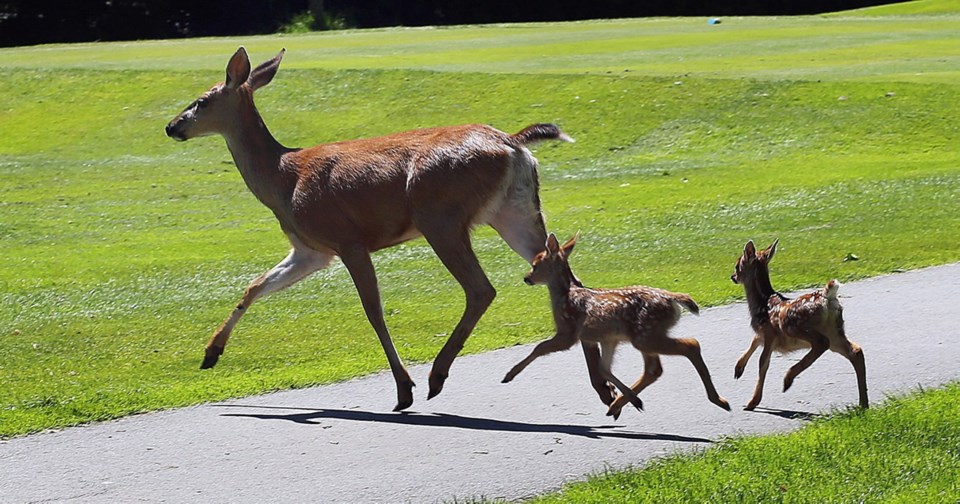Small herds of deer roam freely at the Figueiras Mobile Home Park for seniors in Penticton, feeding on trees and gardens, and leaving bucketloads of droppings in their wake.
“We were filling two-and-half gallon pails with droppings after the snow melted,” said park resident Robert Cartwright. “We like to play horseshoes and bocce, and you really worry about the risk of disease.”
Communities in the Okanagan and the Kootenays are struggling with rising urban deer populations, and some have turned to culls and relocation in hopes of controlling their numbers.
Several dozen deer frequent the mobile home park, said Cartwright.
“You can see individuals roaming around all the time, and they come in herds of six or seven eating everything in sight,” he said.
When two bucks did battle one day, his neighbour’s backyard furniture was reduced to rubble.
“You can hear them crashing their horns when they fight. When they were done, all that two-by-four construction had to be hauled to the dump,” he said.
Deer are frequently born inside the mobile home park, so they are never truly wild, he said.
“We have a six-foot fence and I think it makes them feel protected,” said Cartwright. “We don’t have predators in here yet, but I’m sure they will follow them in eventually.”
A written survey of the park’s 117 residents returned 96 responses in favour of action to reduce the number of deer.
But the deer have nothing to fear from the City of Penticton after council voted Tuesday to maintain the “status quo,” which means no relocation or cull is forthcoming.
The same day, a man was thrown from his scooter after he swerved to avoid three deer crossing a Penticton street, Cartwright said.
About 50 to 60 deer are collected by the city as road kill each year, according to a staff report to council.
A handful of communities — Cranbrook, Invermere, Grand Forks and Kimberly — have taken a more aggressive approach to deer management using a mix of culls, relocation and feeding restrictions.
Kimberley euthanized 99 deer caught in clover traps in 2012 from a population of 242, mainly from areas with high numbers of complaints about aggressive deer.
The population density in the area dropped from 24 deer per square kilometre to about 12 for the next four years, although that effect might have been enhanced by a die-off due to a harsh winter, said Jesse Zeeman, a spokesman for the B.C. Wildlife Federation.
Nonetheless, the number of aggressive-deer complaints and the number of injured deer that had to be destroyed — usually after a motor vehicle collision — also dropped substantially for the four-year period.
Deer have such high growth rates that for culls to work, you have to cull a lot of deer,” said Zeeman. “There is really no natural predation in urban areas.”
Excessive numbers of deer habituated to urban areas are associated with damage to landscapes, injuries to pets and to people, he said.
“If the average cost of a vehicle collision with a deer is $10,000, that is a cost that is borne by all of us through ICBC,” he said.
Motorists strike about 5,500 wild animals a year in B.C., and about 80 per cent of those are deer, according to the Ministry of Transportation.
While relocation projects are viewed as being more humane, they are typically less successful than culls and many of the animals will die anyway.
“While half of the [relocated] deer survive their first year in the wild, for the rest it often means getting eaten by a cougar, run over by a car, or returning to another town where they are euthanized,” said Zeeman.
At about $1,000 per animal, the cost of capture and relocation can be onerous. Cranbrook’s 2017 cull of 15 deer cost about $550 a head.
Last year, Oak Bay adopted a $40,000 program, funded by the municipality and the province, to control the deer population using immunocontraception.
About 40 deer are found dead in Oak Bay each year, mostly hit by vehicles or entangled or impaled on fences.
Kimberley opted to do a relocation of about 50 deer in 2017 and was making plans for another round when the city abruptly disbanded its urban deer committee, citing dysfunction.
Towns that rely on tourism are especially sensitive to public backlash from outside the community over deer culls, even when there is strong support among residents, said Zeeman.
“A very small number of people are opposed to managing the deer population, but their voices end up carrying the day,” he said.



